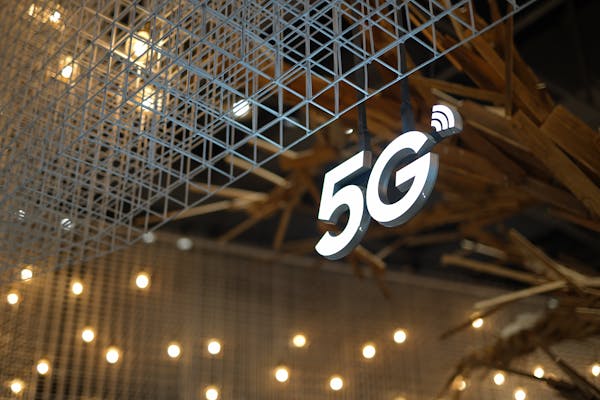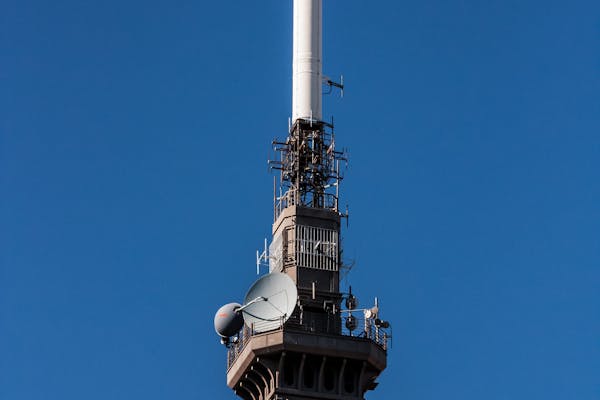Technology is evolving at a rapid pace, and 5G is one of the most transformative innovations shaping our future. As the fifth generation of mobile networks, 5G is designed to revolutionize the way we communicate, interact with technology, and experience the digital world. Its impact will go beyond mobile communications, transforming industries, urban development, and global economies. The benefits of 5G technology range from lightning-fast internet speeds to enabling a vast array of new applications, all of which will pave the way for a more connected and intelligent world.

In this detailed exploration, we will break down what 5G is, how it works, and the incredible advantages it brings to both consumers and industries. We’ll also delve into the challenges of implementing 5G and provide a look into its future potential.
Understanding 5G Technology
5G stands for the fifth generation of mobile network technology. It follows in the footsteps of previous generations like 1G (analog voice), 2G (digital voice and basic data), 3G (mobile internet), and 4G (broadband internet with enhanced data capabilities). However, 5G isn’t just about making the internet on your phone faster; it’s about fundamentally changing the way data is transmitted and how devices communicate with each other.
At its core, 5G offers a new kind of network specifically designed to connect virtually everything and everyone, including machines, objects, and devices. The goal of 5G is not only to provide faster internet speeds but also to support new technologies like artificial intelligence (AI), the Internet of Things (IoT), autonomous vehicles, and smart cities, all of which require an unprecedented level of connectivity and data processing.
The Key Technologies Behind 5G
- Millimeter Waves (mmWave): One of the most significant technological advancements in 5G is the use of millimeter waves. Unlike the lower frequencies used by previous mobile networks, millimeter waves operate at much higher frequencies (24 GHz and above), allowing for greater data transmission rates. This high-frequency range can carry enormous amounts of data, but its trade-off is reduced range and penetration through obstacles like buildings. To overcome this, 5G networks rely on small cells—miniature base stations installed in dense clusters to provide seamless coverage.
- Massive MIMO (Multiple Input, Multiple Output): MIMO technology is already in use with 4G networks, but 5G takes it to a new level. MIMO involves multiple antennas at both the transmitter and receiver ends to send and receive more data streams simultaneously. With massive MIMO, 5G can manage even more data connections, vastly increasing network capacity and allowing it to handle more devices in crowded areas.
- Beamforming: Traditional mobile networks broadcast signals in all directions, but this can lead to interference and inefficiency. Beamforming, a technique used in 5G, directs wireless signals toward specific devices, ensuring a stronger connection and reducing signal loss. This increases efficiency, reduces interference, and improves data transmission speed and reliability.
- Network Slicing: One of the more innovative aspects of 5G is its ability to “slice” the network into multiple virtual networks that can be customized for different applications or industries. For example, an autonomous vehicle might require a network slice with extremely low latency, while a connected smart meter might prioritize low power consumption. This flexibility makes 5G ideal for a wide range of uses, from consumer-level applications to mission-critical industrial processes.
- Edge Computing: To minimize latency, 5G leverages edge computing, which brings data processing closer to the device or user instead of sending it all the way to a central cloud server. By processing data closer to its source, 5G can reduce lag times and enhance real-time applications like virtual reality (VR), augmented reality (AR), and autonomous driving.
The Benefits of 5G Technology
While the technical aspects of 5G are impressive, the real excitement comes from the benefits of 5G technology. These go beyond just faster internet for your smartphone—they span industries, business models, and everyday life. Below, we explore these key benefits in more depth:
1. Faster Internet Speeds
Perhaps the most anticipated benefit of 5G is its dramatically faster data speeds. Current 4G networks typically deliver speeds of around 100 Mbps, while 5G networks can potentially reach download speeds of 10 Gbps—up to 100 times faster. This means that users can download movies, music, and other large files in seconds rather than minutes. High-definition and even 4K streaming will be smooth and instantaneous, while buffering will become a thing of the past.
These faster speeds also enable new types of applications that were not feasible on 4G, including seamless video conferencing, virtual reality gaming, and real-time collaboration on large-scale projects. Beyond personal use, industries like media, advertising, and gaming will benefit immensely from this enhanced speed, allowing them to create richer and more immersive content.
2. Ultra-Low Latency
Latency is the delay between sending a command and receiving a response, and it can be a significant barrier for applications requiring real-time feedback, such as online gaming, video conferencing, or remote surgeries. 4G networks typically have latency between 30 and 50 milliseconds, while 5G promises to reduce this to as little as 1 millisecond.
This ultra-low latency will enable advancements in areas that demand instant responses, such as:
- Autonomous vehicles, need to communicate with each other, traffic systems, and road infrastructure to navigate safely.
- Remote healthcare, including telesurgery, where doctors can perform surgeries on patients in different locations using robotic systems controlled in real-time.
- Augmented reality (AR) and virtual reality (VR) applications, where minimal lag is critical for a seamless user experience.
3. Increased Network Capacity
The number of connected devices worldwide is growing at an exponential rate. In 2019, there were about 26.6 billion connected devices, and this figure is expected to grow to 75.4 billion by 2025. 5G has been designed to accommodate this massive increase in connected devices. Where 4G networks can support around 2,000 devices per square kilometer, 5G can support up to 1 million devices per square kilometer.
This increased capacity is essential for the continued expansion of the Internet of Things (IoT). From smart home devices and wearables to connected cars and industrial machinery, 5G will ensure that networks can handle the influx of IoT devices without becoming congested. For industries like agriculture, manufacturing, and logistics, 5G’s ability to support millions of devices means better tracking, automation, and monitoring of equipment and products in real time.
4. Enhanced Reliability
Reliability is one of the most important factors in mission-critical applications, such as autonomous vehicles, healthcare, and emergency services. 5G networks are designed to be more reliable than their predecessors, with features such as improved signal penetration, real-time monitoring, and enhanced network redundancy.
For example, in autonomous vehicles, reliability is crucial. Cars must communicate with each other and with traffic systems at all times to avoid accidents and ensure the smooth flow of traffic. Similarly, in healthcare, doctors need to trust that telemedicine systems will not fail during a critical procedure.
Enhanced reliability also extends to businesses, where downtime can be costly. With 5G, businesses can leverage cloud-based applications, video conferencing, and other tools without the fear of dropped connections or lagging performance.
5. Support for Emerging Technologies
The benefits of 5G technology are not just limited to improving existing applications; they also lie in supporting and enabling entirely new technologies. As mentioned earlier, 5G will act as the backbone for several emerging technologies, including:
- Autonomous vehicles: Self-driving cars rely on a constant stream of data from various sources, including road infrastructure, GPS, and other vehicles. 5G’s low latency and high capacity will allow these cars to make real-time decisions, improving safety and efficiency.
- Smart cities: Urban areas are becoming increasingly connected, with IoT devices monitoring everything from traffic and public transportation to energy usage and waste management. 5G will enable these systems to communicate and react in real time, making cities more efficient, sustainable, and livable.
- AR and VR: With 5G, users will experience truly immersive AR and VR applications, whether in gaming, education, or training. High-speed, low-latency connections mean that users will be able to engage with virtual environments without any noticeable lag or delay.
- Drones: Drones for delivery, agriculture, and even surveillance will be able to communicate over 5G networks, allowing for more precise control and real-time data transmission.
The Impact of 5G on Various Industries

While consumers will undoubtedly benefit from faster internet and better connectivity, the real transformation will be felt across a wide range of industries. The benefits of 5G technology will unlock new efficiencies, reduce costs, and open up new revenue streams for businesses. Here are a few industries that stand to gain the most from 5G:
1. Healthcare
5G’s low latency and high reliability are critical for the next wave of telemedicine and remote healthcare. With 5G, patients can be monitored in real-time using wearable devices that send data directly to healthcare providers, allowing doctors to diagnose and treat conditions more quickly and accurately. Remote surgery, where a surgeon controls robotic instruments from a distance, will also become more feasible, thanks to the ultra-low latency of 5G networks.
Additionally, 5G will enable the growth of AI-powered diagnostics, allowing healthcare providers to analyze vast amounts of medical data quickly and efficiently. This will lead to earlier detection of diseases and more personalized treatment plans.
2. Manufacturing
5G will power the next generation of smart factories, where IoT devices, robots, and artificial intelligence work together to optimize production processes. Real-time data analysis will enable manufacturers to identify and address issues before they impact productivity, leading to reduced downtime and increased efficiency.
Moreover, 5G will enable greater automation in factories, with robots communicating seamlessly with each other and central systems. This will lead to faster production times, reduced human error, and ultimately lower costs for manufacturers.
3. Entertainment
The media and entertainment industries are poised to be transformed by 5G. With faster data speeds and lower latency, 5G will enable new types of content creation and distribution, such as immersive AR and VR experiences, live streaming of 8K video, and interactive gaming with no perceptible lag.
For example, in live sports, 5G will allow broadcasters to use multiple camera angles, augmented reality overlays, and real-time statistics, providing a more engaging and personalized viewing experience for fans. In gaming, 5G will enable seamless cloud gaming, where users can play high-end games without needing a console or powerful PC.
4. Agriculture
The agricultural industry is increasingly relying on connected devices to monitor crops, track weather patterns, and manage resources more efficiently. 5G will allow farmers to gather and analyze data from sensors in real-time, helping them optimize water usage, monitor soil conditions, and track the health of livestock.
Drones equipped with 5G technology will also play a crucial role in modern agriculture. These drones can be used for precision farming, such as spraying pesticides or fertilizers with pinpoint accuracy, which reduces waste and minimizes the environmental impact.
5. Retail
The retail industry is undergoing a transformation with the rise of e-commerce, and 5G will accelerate this trend. With 5G, retailers can offer personalized shopping experiences, such as virtual try-ons and real-time product recommendations. Augmented reality apps will allow customers to see how furniture looks in their homes or try on clothes virtually before making a purchase.
In addition, 5G will improve inventory management and logistics. Retailers can use IoT devices to track products from the warehouse to the store shelf, ensuring that inventory is always up to date and reducing the risk of stockouts.
Challenges to 5G Implementation
Despite the numerous benefits of 5G technology, there are also several challenges that must be overcome for its widespread adoption.
- Infrastructure Costs: Deploying 5G networks requires a significant investment in infrastructure. Telecom operators must install new cell towers, small cells, and fiber-optic cables to support the high-frequency signals of 5G. These costs can be prohibitive, especially in rural or remote areas, where the population density may not justify the investment.
- Spectrum Allocation: 5G requires access to new frequency bands, including millimeter-wave spectrum, which is in limited supply. Governments and regulatory bodies must work to allocate and auction off this spectrum to telecom operators, which can be a complex and time-consuming process.
- Device Compatibility: While many smartphone manufacturers have already released 5G-compatible devices, it will take time for consumers to upgrade to these new devices. Moreover, IoT devices, industrial equipment, and other connected technologies will also need to be upgraded or replaced to support 5G.
- Security Concerns: As more devices are connected to the internet through 5G, the risk of cyberattacks and data breaches increases. Ensuring the security of 5G networks will require robust encryption, authentication, and cybersecurity measures to protect both personal data and critical infrastructure.
- Health and Environmental Concerns: Some people have raised concerns about the potential health effects of exposure to 5G radiation, although current scientific evidence does not support these claims. Additionally, the environmental impact of building and maintaining 5G infrastructure, including energy consumption and electronic waste, must be considered.
The Future of 5G
The benefits of 5G technology are immense, but we are only at the beginning of its rollout. Over the next few years, 5G will become more widespread, with coverage expanding to rural areas and more devices becoming 5G-compatible. As the technology matures, we will see new applications and innovations that we can hardly imagine today.
In the future, 5G could power everything from autonomous drone deliveries to immersive virtual reality classrooms. It could also enable advancements in fields like artificial intelligence, quantum computing, and biotechnology, as these technologies rely on the high-speed, low-latency, and massive connectivity that 5G provides.
5G technology represents a monumental leap forward in the evolution of wireless communication. Its benefits including faster speeds, lower latency, increased capacity, and enhanced reliability—will not only improve everyday experiences but also unlock new possibilities for businesses and industries around the world.
From healthcare and manufacturing to entertainment and transportation, the benefits of 5G technology will be felt across all sectors of the economy. While there are challenges to overcome, the potential of 5G is too great to ignore. As we move into the next decade, 5G will be the foundation upon which the digital economy of the future is built, creating opportunities for innovation, growth, and improved quality of life.





